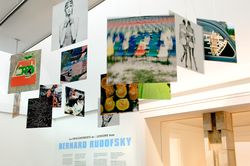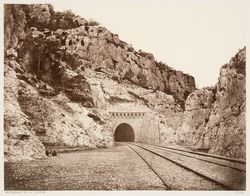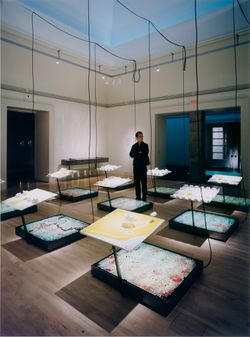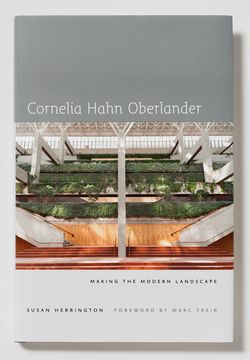Les enseignements de Bernard Rudofsky est la première rétrospective qui examine la vie et l’œuvre de l’architecte, designer et critique controversé, dont les constructions, les expositions et les concepts de mode ont remis en question les idées mêmes de confort et de culture dans le monde occidental. L’exposition jette un regard sur la diversité des contributions d’un(...)
Salles principales
4 juillet 2007 au 30 septembre 2007
Les enseignements de Bernard Rudofsky
Actions:
Description:
Les enseignements de Bernard Rudofsky est la première rétrospective qui examine la vie et l’œuvre de l’architecte, designer et critique controversé, dont les constructions, les expositions et les concepts de mode ont remis en question les idées mêmes de confort et de culture dans le monde occidental. L’exposition jette un regard sur la diversité des contributions d’un(...)
Salles principales
recherche
Chercheurs en résidence 2005
Paolo Amaldi, Université catholique de Louvain (UCL), Louvain-La-Neuve, Belgique Sujet : Analyse du rapport entre espace architectural et instrument de représentation dans l’oeuvre de Mies van der Rohe Jean-François Bédard, Paris Program, Columbia University, New York, États-Unis Sujet : Honnêteté and the Grotesque: a Study of the Album by Gilles-Marie Oppenord(...)
3 janvier 2005 au 30 septembre 2005
Chercheurs en résidence 2005
Actions:
Description:
Paolo Amaldi, Université catholique de Louvain (UCL), Louvain-La-Neuve, Belgique Sujet : Analyse du rapport entre espace architectural et instrument de représentation dans l’oeuvre de Mies van der Rohe Jean-François Bédard, Paris Program, Columbia University, New York, États-Unis Sujet : Honnêteté and the Grotesque: a Study of the Album by Gilles-Marie Oppenord(...)
recherche
3 janvier 2005 au
30 septembre 2005
documents textuels
AP197.S1.SS9.014
Description:
The box contains drafts, final copies, notes and correspondence for various articles, interviews, keynote addresses, and lectures by Kenneth Frampton. The materials are organized in alphabetical order, from FR- I. The largest portion of this box consists of articles, correspondence and research files on Tony Fretton; a dossier on the 1994 Mies van der Rohe Pavilion Award in which Frampton was a nominator from 1994-1996; various articles, drafts and correspondence on Steven Holl; drafts of "Homage a Finlandia: Finnish Architecture and the Unfinished Modern Project," a Nils Wickberg lecture, Aalto University; and correspondence and drafts of a Michael Hopkins essay featured in "Hopkins: the work of Michael Hopkins and Partners." Other subjects and architects explored in these texts relate to: Tony Fretton; Hiromi Fuiji; futurism; on Galfetti's Aula; Antoni Gaudí; globalism and its discontents; Giorgio Grassi; Vittorio Gregotti; the Guggenheim; Dan S. Hanganu; the work of Hariri Hariri; Herman Hertzberger; homage to Iberia; industrialization; and an introduction to "Inside Architecture" by Vittorio Gregotti.
circa 1971-2015
Kenneth Frampton writings (FR-I)
Actions:
AP197.S1.SS9.014
Description:
The box contains drafts, final copies, notes and correspondence for various articles, interviews, keynote addresses, and lectures by Kenneth Frampton. The materials are organized in alphabetical order, from FR- I. The largest portion of this box consists of articles, correspondence and research files on Tony Fretton; a dossier on the 1994 Mies van der Rohe Pavilion Award in which Frampton was a nominator from 1994-1996; various articles, drafts and correspondence on Steven Holl; drafts of "Homage a Finlandia: Finnish Architecture and the Unfinished Modern Project," a Nils Wickberg lecture, Aalto University; and correspondence and drafts of a Michael Hopkins essay featured in "Hopkins: the work of Michael Hopkins and Partners." Other subjects and architects explored in these texts relate to: Tony Fretton; Hiromi Fuiji; futurism; on Galfetti's Aula; Antoni Gaudí; globalism and its discontents; Giorgio Grassi; Vittorio Gregotti; the Guggenheim; Dan S. Hanganu; the work of Hariri Hariri; Herman Hertzberger; homage to Iberia; industrialization; and an introduction to "Inside Architecture" by Vittorio Gregotti.
documents textuels
circa 1971-2015
dessins, graphique
AP197.S4.010
Description:
This box contains various drawings and collages, some of which are dedicated to Frampton. The box also comprises of posters for lectures/conferences/events that Frampton may have either participated in or attended. Posters include: the lecture on the Imaginary space of El Lissitzky, Harvard University; Place, form, and cultural identity, École polytechnique fédérale de Lausanne; the Alcan Lectures, McGill University; and Modern Architecture and Critique of Ulm, the University of Southern California. Also included in the box is a poster of the Museum of Contemporary Art Los Angeles, which is signed by Arata Isozaki.
circa 1978-2015
Posters and prints
Actions:
AP197.S4.010
Description:
This box contains various drawings and collages, some of which are dedicated to Frampton. The box also comprises of posters for lectures/conferences/events that Frampton may have either participated in or attended. Posters include: the lecture on the Imaginary space of El Lissitzky, Harvard University; Place, form, and cultural identity, École polytechnique fédérale de Lausanne; the Alcan Lectures, McGill University; and Modern Architecture and Critique of Ulm, the University of Southern California. Also included in the box is a poster of the Museum of Contemporary Art Los Angeles, which is signed by Arata Isozaki.
dessins, graphique
circa 1978-2015
Édouard Baldus a défini mieux qu’aucun autre la notion moderne de paysage et les critères de la photographie d’architecture. Les photographies d’Édouard Baldus : paysages et monuments de France témoigne de l’âge d’or français du point de vue du photographe. L’exposition se présente comme une suite chronologique de séquences qui montrent l’évolution du travail de l’artiste(...)
Salles principales
25 janvier 1995 au 23 avril 1995
Les photographies d'Édouard Baldus : paysages et monuments de France
Actions:
Description:
Édouard Baldus a défini mieux qu’aucun autre la notion moderne de paysage et les critères de la photographie d’architecture. Les photographies d’Édouard Baldus : paysages et monuments de France témoigne de l’âge d’or français du point de vue du photographe. L’exposition se présente comme une suite chronologique de séquences qui montrent l’évolution du travail de l’artiste(...)
Salles principales
documents textuels
AP197.S1.SS9.001
Description:
This box contains notes, drafts, articles, book reviews and lectures by Kenneth Frampton. The materials are organized alphabetically by either title or the architect's last name, from A-Z. The contents are mostly older texts by Frampton, circa 1960-1990. Subjects and architects explored in these texts include: Raimund Abraham; Tadao Ando; contemporary architecture; the modern urban form; Gustave Eiffel; English neoclassicism; Louis Kahn; John Hejduk; Herman Hertzberger; postmodern theory; Steven Holl; industrialization; Le Corbusier; El Lissitzky; modernism; Palais Royale; Carlo Scarpa; James Stirling; Team 10; technology; and Otto Wagner.
circa 1964-1990
Kenneth Frampton texts, articles and notes (A-Z)
Actions:
AP197.S1.SS9.001
Description:
This box contains notes, drafts, articles, book reviews and lectures by Kenneth Frampton. The materials are organized alphabetically by either title or the architect's last name, from A-Z. The contents are mostly older texts by Frampton, circa 1960-1990. Subjects and architects explored in these texts include: Raimund Abraham; Tadao Ando; contemporary architecture; the modern urban form; Gustave Eiffel; English neoclassicism; Louis Kahn; John Hejduk; Herman Hertzberger; postmodern theory; Steven Holl; industrialization; Le Corbusier; El Lissitzky; modernism; Palais Royale; Carlo Scarpa; James Stirling; Team 10; technology; and Otto Wagner.
documents textuels
circa 1964-1990
Sous-série
CI001.S2.D5
Description:
Charles Rohault de Fleury was architect for the Muséum national d'histoire naturelle from 1833 to 1862. His work for the Muséum is represented in the CCA collection by a diverse group of prints and drawings. In addition to documenting his built and unbuilt projects, the inclusion of prints and drawings of museum and zoo buildings by other architects record, if only partially, the resources available to Charles in designing his buildings. This reference material provides insight into the influences on Charles' work as well as the nature of the design process itself. His built works, with the exception of the 1854 addition to the greenhouses, are illustrated in a book of prints with a brief accompanying text - "Muséum d'histoire naturelle: serres chaudes, galeries de minéralogie, etc. etc." (published 1837) (DR1974:0002:004:001; a second copy is held by the CCA library) (1). While prints are included for the Galerie de minéralogie et de géologie, the monkey house and the reservoirs, the majority of the prints are of the greenhouses (serres chaudes) begun 1833 (2). Known for their technological innovations in iron construction, these greenhouses utilized the first multi-storey load-bearing cast-iron façades for the central pavilions as well as space frame roof structures and prefabricated parts. This structural system is well documented in the prints in the CCA collection. The design was apparently inspired by the English greenhouses - a plate of which are included in the book - that Charles saw on a tour of England. The use of prestressed beams and curved roofs in the lateral wings attest to this influence. Charles' greenhouses, in turn, influenced the design of other greenhouses in Europe especially those at the Jardins Botanique in Liège and Ghent, Belgium (3). Although Joseph Paxton saw the greenhouses in 1833, it is unclear if they had an impact on the design of the Crystal Palace constructed 1850-1851 (4). The innovations of Charles' greenhouses continued to be acknowledged into the 20th century. Giedion in "Space, Time and Architecture", while erroneously attributing them to Rouhault (5)(6), refers to the greenhouses as "the prototype of all large iron-framed conservatories" (7). In addition to the greenhouses for the Muséum, the CCA collection includes three proposals (dated 1841) for a private greenhouse designed by Charles Rohault de Fleury (DR1974:0002:002:008 - DR1974:0002:002:013). The designs utilize the same curved roofs as the wings of the greenhouses at the Muséum combined with classically detailed stonework. An different aspect of Charles' work for the Muséum national d'histoire naturelle is represented in the album of unexecuted proposals -the only design drawings for the Muséum in the collection - for a Galerie de zoologie (DR1974:0002:024:001-079). Building on the typology of his earlier classical Galerie de minéralogie et de géologie (constructed 1833 -1841), the proposals, which date from between 1838 and 1862, illustrate a gradual enrichment of Charles' classical architectural vocabulary (8). They vary in their spatial configurations and façade treatments ranging from austere colonnaded designs with little ornament to more elaborate ones with richly encrusted facades, complex rooflines and more dramatic interior spaces characteristic of the Second Empire. The majority of the proposals consist of preliminary drawings illustrating the essential formal, spatial and ornamental aspects of the building. One proposal, dated January 1846, is substantially more developed than the others; in addition to general plans, sections and elevations, more detailed drawings are included for the layout of spaces, the elaboration of the facades, the configuration of the structure and even the designs for the specimen display cases. It is also worth noting that this album includes several plans outlining Rohault de Fleury's ideas for the overall development of the Muséum national d'histoire naturelle. In 1846, an album of prints of the Museo di fiscia e storia naturelle in Florence (DR1974:0002:005:001-018) was presented to Charles by the Grand Duke of Tuscany in response to his request for tracings of that building. These prints were probably used as reference material for the design of the new Galerie de zoologie described above. The portfolio of record drawings (ca. 1862) of the zoos in Antwerp, Brussels, Marseille and Amsterdam (DR1974:0002:018:001-027) is probably a dummy for a publication on zoological gardens as well as background documentation for the renovation and expansion of the zoo at the Muséum national d'histoire naturelle in Paris. Both drawings of the facilities for the animals and visitors and general plans of the zoological gardens are included. The Paris zoo project was apparently never undertaken. (1) These prints were reused in the "Oeuvre de C. Rohault de Fleury, architecte" (published 1884) (DR1974:0002:029:001-044). (2) Rohault de Fleury's greenhouses were destroyed in the Prussian bombardments of 1870. The greenhouses, which now stand in their place, are similar in layout and appearance to the original design, but their structural system is different. (3) John Hix, 'The Glass House' (Cambridge, Mass.: The MIT Press, 1981), p. 115. (4) Ibid., p. 115. (5) This error has been repeated by other authors including Henry-Russell Hitchcock, 'Architecture: Nineteenth and Twentieth Centuries' (Baltimore, Maryland: Penguin Books, 1968), p. 120. (6) Leonardo Benevolo, 'History of Modern Architecture' Volume 1: The tradition of modern architecture (Cambridge, Mass.: The M.I.T. Press, 1971), p. 22. (7) Sigfried Giedion, 'Space, Time and Architecture; the growth of a new tradition' (Cambridge: Harvard University Press, 1941), p. 181. (8) Barry Bergdoll, "Charles Rohault de Fleury: Part two: Muséum d'Histoire Naturelle and Studies on analogous Constructions in Europe", 'CCA Research Report", n.d., p. 1.
[1837-ca. 1862]
Muséum nationale d'histoire naturelle
CI001.S2.D5
Description:
Charles Rohault de Fleury was architect for the Muséum national d'histoire naturelle from 1833 to 1862. His work for the Muséum is represented in the CCA collection by a diverse group of prints and drawings. In addition to documenting his built and unbuilt projects, the inclusion of prints and drawings of museum and zoo buildings by other architects record, if only partially, the resources available to Charles in designing his buildings. This reference material provides insight into the influences on Charles' work as well as the nature of the design process itself. His built works, with the exception of the 1854 addition to the greenhouses, are illustrated in a book of prints with a brief accompanying text - "Muséum d'histoire naturelle: serres chaudes, galeries de minéralogie, etc. etc." (published 1837) (DR1974:0002:004:001; a second copy is held by the CCA library) (1). While prints are included for the Galerie de minéralogie et de géologie, the monkey house and the reservoirs, the majority of the prints are of the greenhouses (serres chaudes) begun 1833 (2). Known for their technological innovations in iron construction, these greenhouses utilized the first multi-storey load-bearing cast-iron façades for the central pavilions as well as space frame roof structures and prefabricated parts. This structural system is well documented in the prints in the CCA collection. The design was apparently inspired by the English greenhouses - a plate of which are included in the book - that Charles saw on a tour of England. The use of prestressed beams and curved roofs in the lateral wings attest to this influence. Charles' greenhouses, in turn, influenced the design of other greenhouses in Europe especially those at the Jardins Botanique in Liège and Ghent, Belgium (3). Although Joseph Paxton saw the greenhouses in 1833, it is unclear if they had an impact on the design of the Crystal Palace constructed 1850-1851 (4). The innovations of Charles' greenhouses continued to be acknowledged into the 20th century. Giedion in "Space, Time and Architecture", while erroneously attributing them to Rouhault (5)(6), refers to the greenhouses as "the prototype of all large iron-framed conservatories" (7). In addition to the greenhouses for the Muséum, the CCA collection includes three proposals (dated 1841) for a private greenhouse designed by Charles Rohault de Fleury (DR1974:0002:002:008 - DR1974:0002:002:013). The designs utilize the same curved roofs as the wings of the greenhouses at the Muséum combined with classically detailed stonework. An different aspect of Charles' work for the Muséum national d'histoire naturelle is represented in the album of unexecuted proposals -the only design drawings for the Muséum in the collection - for a Galerie de zoologie (DR1974:0002:024:001-079). Building on the typology of his earlier classical Galerie de minéralogie et de géologie (constructed 1833 -1841), the proposals, which date from between 1838 and 1862, illustrate a gradual enrichment of Charles' classical architectural vocabulary (8). They vary in their spatial configurations and façade treatments ranging from austere colonnaded designs with little ornament to more elaborate ones with richly encrusted facades, complex rooflines and more dramatic interior spaces characteristic of the Second Empire. The majority of the proposals consist of preliminary drawings illustrating the essential formal, spatial and ornamental aspects of the building. One proposal, dated January 1846, is substantially more developed than the others; in addition to general plans, sections and elevations, more detailed drawings are included for the layout of spaces, the elaboration of the facades, the configuration of the structure and even the designs for the specimen display cases. It is also worth noting that this album includes several plans outlining Rohault de Fleury's ideas for the overall development of the Muséum national d'histoire naturelle. In 1846, an album of prints of the Museo di fiscia e storia naturelle in Florence (DR1974:0002:005:001-018) was presented to Charles by the Grand Duke of Tuscany in response to his request for tracings of that building. These prints were probably used as reference material for the design of the new Galerie de zoologie described above. The portfolio of record drawings (ca. 1862) of the zoos in Antwerp, Brussels, Marseille and Amsterdam (DR1974:0002:018:001-027) is probably a dummy for a publication on zoological gardens as well as background documentation for the renovation and expansion of the zoo at the Muséum national d'histoire naturelle in Paris. Both drawings of the facilities for the animals and visitors and general plans of the zoological gardens are included. The Paris zoo project was apparently never undertaken. (1) These prints were reused in the "Oeuvre de C. Rohault de Fleury, architecte" (published 1884) (DR1974:0002:029:001-044). (2) Rohault de Fleury's greenhouses were destroyed in the Prussian bombardments of 1870. The greenhouses, which now stand in their place, are similar in layout and appearance to the original design, but their structural system is different. (3) John Hix, 'The Glass House' (Cambridge, Mass.: The MIT Press, 1981), p. 115. (4) Ibid., p. 115. (5) This error has been repeated by other authors including Henry-Russell Hitchcock, 'Architecture: Nineteenth and Twentieth Centuries' (Baltimore, Maryland: Penguin Books, 1968), p. 120. (6) Leonardo Benevolo, 'History of Modern Architecture' Volume 1: The tradition of modern architecture (Cambridge, Mass.: The M.I.T. Press, 1971), p. 22. (7) Sigfried Giedion, 'Space, Time and Architecture; the growth of a new tradition' (Cambridge: Harvard University Press, 1941), p. 181. (8) Barry Bergdoll, "Charles Rohault de Fleury: Part two: Muséum d'Histoire Naturelle and Studies on analogous Constructions in Europe", 'CCA Research Report", n.d., p. 1.
File 5
[1837-ca. 1862]
Surface du quotidien : La pelouse en Amérique montre la pelouse comme symbole de la vie domestique, espace public de représentation, agent économique et icône de l’Amérique. Les pavillons des lotissements de banlieue, les sièges d’entreprise établis en milieu suburbain et la Maison Blanche ont une chose en commun : tous ces bâtiments sont entourés d’une pelouse – une(...)
Salles principales, salle octogonale et vitrines
16 juin 1998 au 8 novembre 1998
Surface du quotidien : la pelouse en Amérique
Actions:
Description:
Surface du quotidien : La pelouse en Amérique montre la pelouse comme symbole de la vie domestique, espace public de représentation, agent économique et icône de l’Amérique. Les pavillons des lotissements de banlieue, les sièges d’entreprise établis en milieu suburbain et la Maison Blanche ont une chose en commun : tous ces bâtiments sont entourés d’une pelouse – une(...)
Salles principales, salle octogonale et vitrines
Première biographie de l’une des architectes de paysage les plus influentes du XXe siècle, Cornelia Hahn Oberlander: Making the Modern Landscape s’appuie sur des recherches archivistiques, des analyses de sites et de nombreuses entrevues avec Cornelia Oberlander et ses collaborateurs. L’auteure Susan Herrington rencontre Oberlander pour une conversation sur son œuvre et(...)
14 septembre 2014 , 15h
Cornelia Oberlander et Susan Herrington veulent vous parler
Actions:
Description:
Première biographie de l’une des architectes de paysage les plus influentes du XXe siècle, Cornelia Hahn Oberlander: Making the Modern Landscape s’appuie sur des recherches archivistiques, des analyses de sites et de nombreuses entrevues avec Cornelia Oberlander et ses collaborateurs. L’auteure Susan Herrington rencontre Oberlander pour une conversation sur son œuvre et(...)
Projet
AP056.S1.2000.PR05
Description:
This project series documents the James Stewart Centre for Mathematics at McMaster University in Hamilton, Ontario from 2000-2003. The office identified the project number as 2000-22. This project consisted of the complete interior renovation of Hamilton Hall, originally built in 1929, for use as a mathematics school at the University. An insulated envelope was added to the historic building in order to preserve its gothic exteriors, which were juxtaposed against new modern and abstract interior spaces. Transparent blue glass was used throughout the four-storey building for walls, ceilings and railings to draw sunlight deep into its interiors. A mix of enclosed rooms and open, interactive spaces were created and slate chalkboards were added throughout the building to inspire spontaneous thought and collaborative work.[1] This project was awarded a Governor General's Medal in Architecture in 2004. The project is recorded through drawings dating from around 2000 to around 2002, which include sketches, plans, elevations, sections, perspectives, details, presentation drawings and digital renderings. A large part of the sketches are drawings for custom furniture. [1]"James Stewart Centre for Mathematics, McMaster University." KPMB. Accessed April 12, 2019. http://www.kpmb.com/project/james-stewart-centre-for-mathematics/
circa 2000-2002
James Stewart Centre for Mathematics, McMaster University, Hamilton, Ontario (2000-2003)
Actions:
AP056.S1.2000.PR05
Description:
This project series documents the James Stewart Centre for Mathematics at McMaster University in Hamilton, Ontario from 2000-2003. The office identified the project number as 2000-22. This project consisted of the complete interior renovation of Hamilton Hall, originally built in 1929, for use as a mathematics school at the University. An insulated envelope was added to the historic building in order to preserve its gothic exteriors, which were juxtaposed against new modern and abstract interior spaces. Transparent blue glass was used throughout the four-storey building for walls, ceilings and railings to draw sunlight deep into its interiors. A mix of enclosed rooms and open, interactive spaces were created and slate chalkboards were added throughout the building to inspire spontaneous thought and collaborative work.[1] This project was awarded a Governor General's Medal in Architecture in 2004. The project is recorded through drawings dating from around 2000 to around 2002, which include sketches, plans, elevations, sections, perspectives, details, presentation drawings and digital renderings. A large part of the sketches are drawings for custom furniture. [1]"James Stewart Centre for Mathematics, McMaster University." KPMB. Accessed April 12, 2019. http://www.kpmb.com/project/james-stewart-centre-for-mathematics/
project
circa 2000-2002



